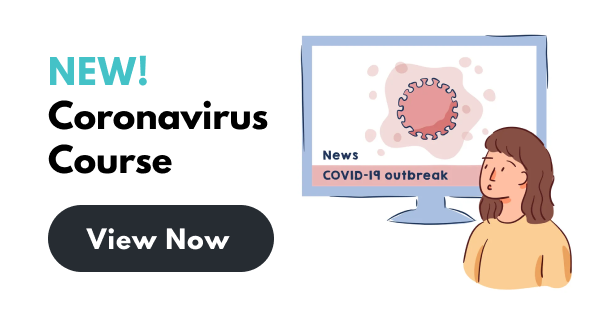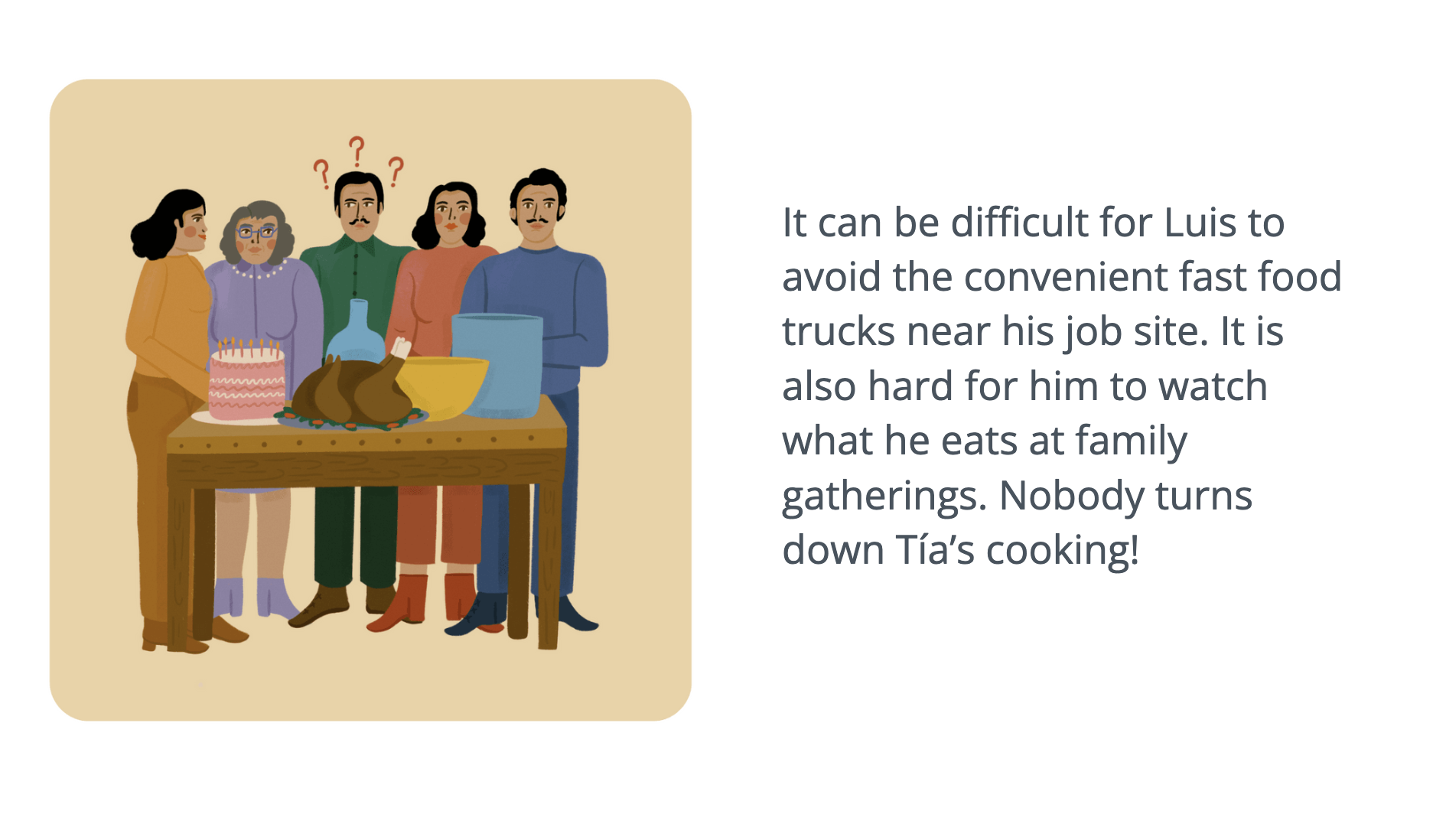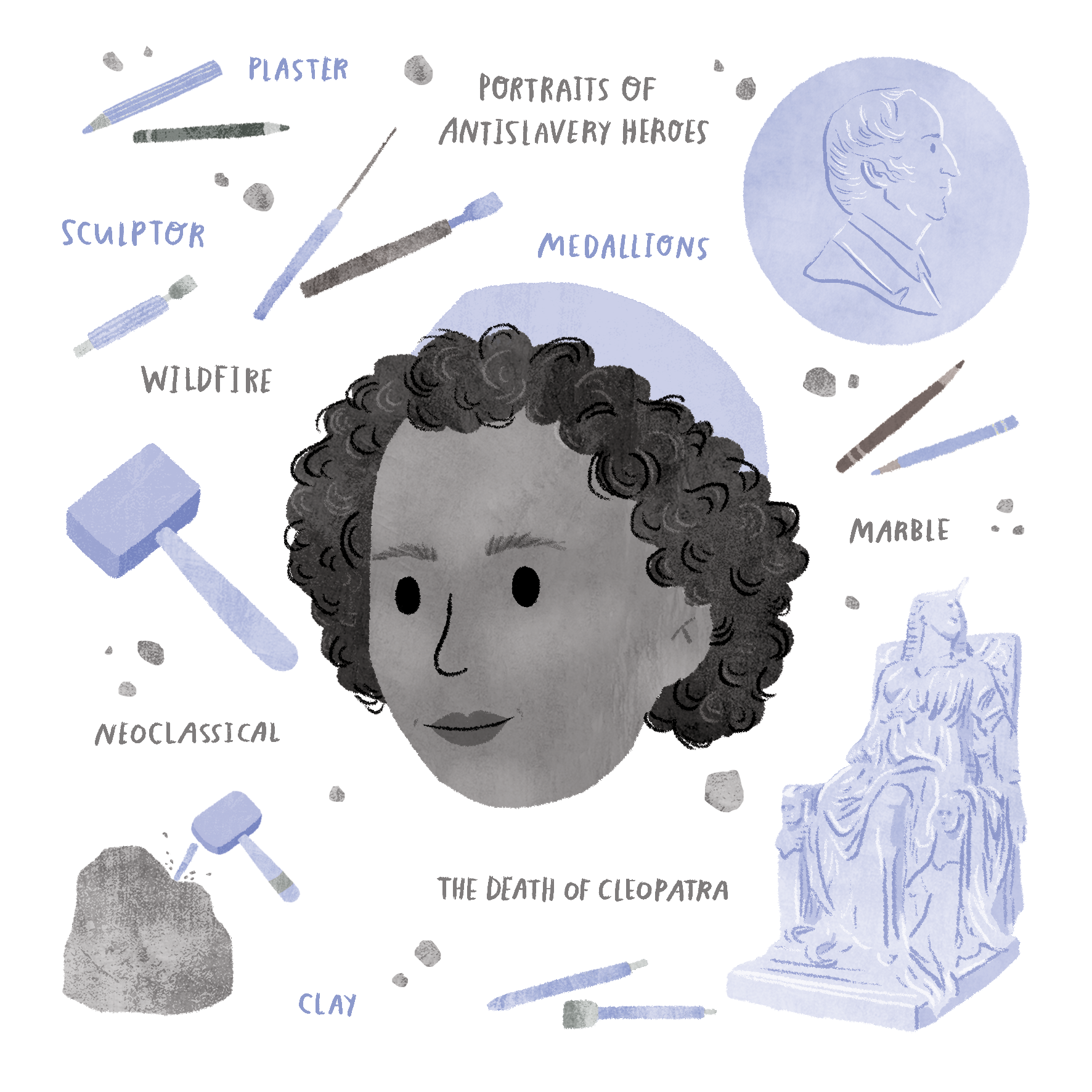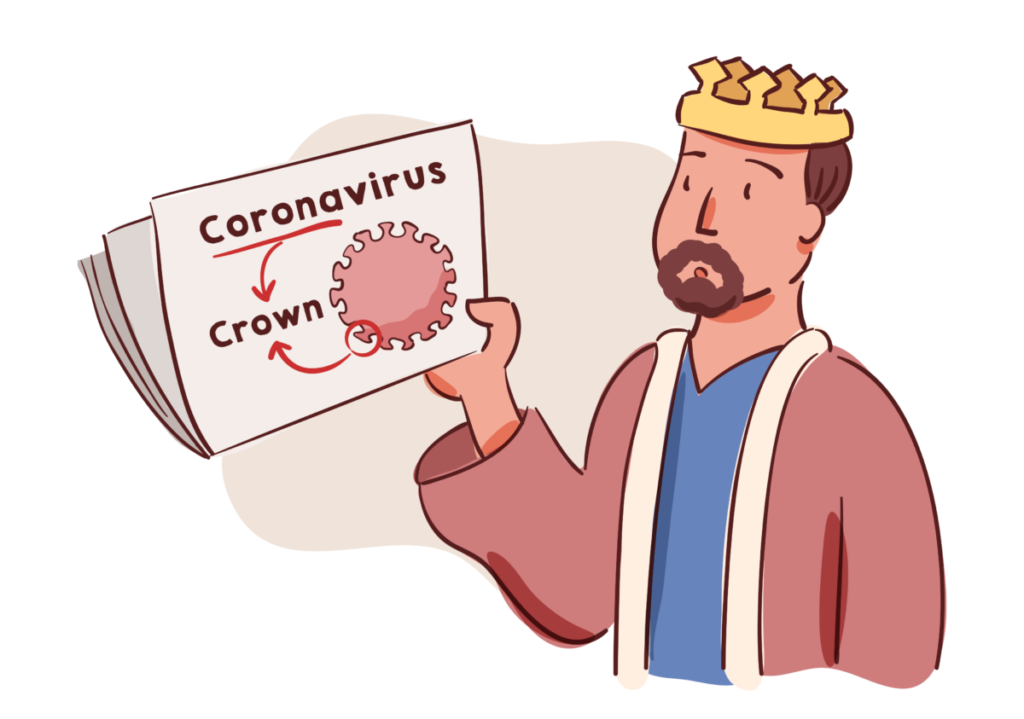
Illustration by Elfy Chiang
At the end of February 2020, I became convinced that our Lifeology team, a team committed to improving science and health communication with accessible stories and art, needed to do something about the information landscape on COVID-19. I was seeing a lot of misinformation, fear and even panic among my own communities in the US, even before many cases had been reported here.
So the Lifeology team decided to create a course on the novel coronavirus. Can’t wait to read to the bottom of this post? View the course now!
Each Lifeology course, which is a series of digital illustrated flashcards organized into an interactive web experience, is a collaboration between one or more scientists or scientific organizations, a science writer, and an artist or visual storyteller. So I started by reaching out to several prominent virologists actively communicating about the virus on social media.
I already had an artist in mind – the fantastic Elfy Chiang had already illustrated several Lifeology courses and was keen to work on a course about the novel coronavirus. She lives in Taiwan and was already seeing the impacts of the virus on the daily lives of people there. She hadn’t illustrated viruses before, but was more than up for the challenge.
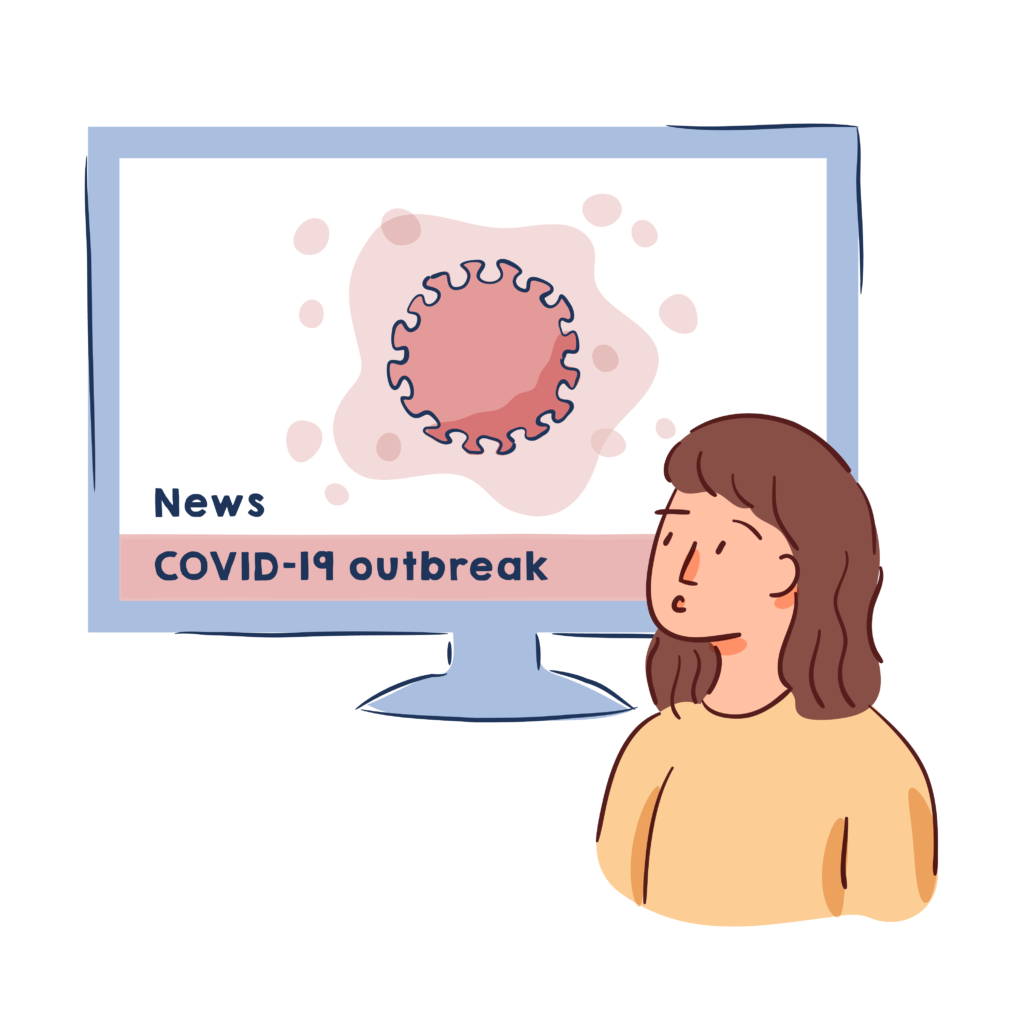
Nervous about COVID-19, by Elfy Chiang.
“This is very relatable to people here in Taiwan at the moment and I think people are very willing to learn more about it and to know how to protect themselves. Especially when there is so much misinformation circulating around and so much uncertainty about the virus.” – E-mail correspondence with Elfy
When virologist and science writer Shauna Bennett responded to a LinkedIn message I sent asking if she could help write the content for an illustrated primer on the novel coronavirus, I knew we had a dream team and we were off to the races!
This course would be a challenge for the Lifeology format (or any communications format, really) because what we knew about the 2019 novel coronavirus and the COVID-19 illness it caused was changing by the minute. We decided that we would focus as much as we could on the human experience of the epidemic – to empower people and combat fear of the unknown – and evergreen preventative measures, like hand-washing.
A Lifeology Process
We started by defining the objectives, target audience, tone, context and story arc of this Lifeology course. This and the bite-sized card content makes up the backbone of every Lifeology course, which then gets transformed by the course artist into a visual storyboard and custom illustrations for every card. The artist is involved early and has feedback on the written content, to maximize the potential for visual metaphors.
Course title: What do I need to know about the 2019 novel coronavirus?
Objectives: Cover the basic science and brief history of the 2019 novel coronavirus; what it is, how it works, where it came from, what it means for the average person.
Story Arc: A character story to educate people about the virus, what it looks like to get sick and aspects of prevention, treatment and recovery.
Tone: Serious, but not scary; visuals should accurately portray real life experiences around coronavirus while being calming and measured, working against sparking any kind of anxiety or fear. Empowering tone for prevention of infection or how to take care of oneself and one’s family if infection occurs.
Audience: Broad audience, but particularly adults who may be in areas that put them at risk of coronavirus infection
Context: People will be encountering this online / in their homes / reading at their leisure; the course should stand alone and not assume any prior experience or knowledge of viruses and how they work scientifically.
Shauna started by doing research, compiling notes to answer common questions (according to Google and Quora) about the coronavirus. Much of the information came from often-updated government websites, such as CDC and WHO. We had interesting email discussions about potential differences in suggestions based on country and region. Shauna read a LOT during this phase of course creation. She talked to several virologists and epidemiology experts. Then she started writing the bite-sized content for the course cards, which we tried to limit to 30-40 cards containing about two sentences each.
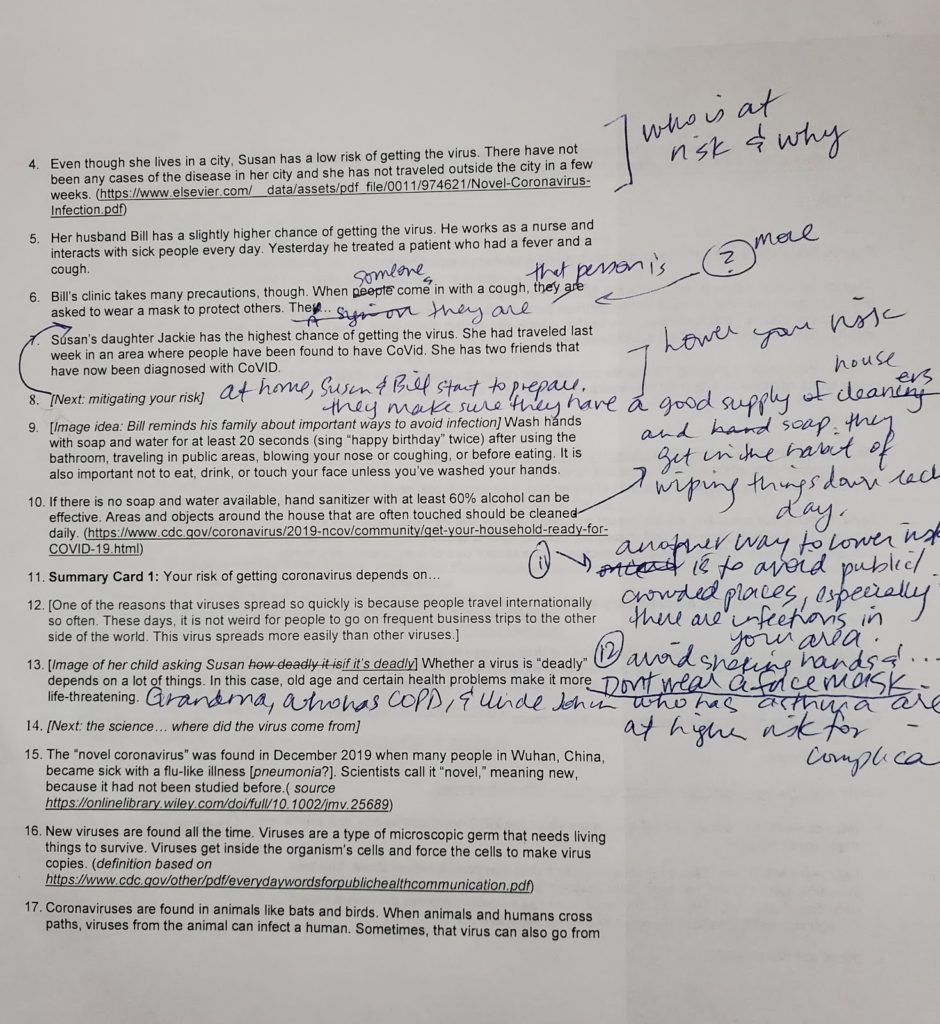
Course writing in progress
Shauna wrote and then we re-wrote that card content, a process that we repeated several times over. What started as a list of questions and answers slowly transformed into the story of a family living in a community that was beginning to be affected by the coronavirus, and what they were thinking about and doing to protect themselves. Once we had all of the written card content laid out, we contacted several virologists and physicians to help review and fact-check our course. Their feedback helped us refine the written content to ensure that it was accurate while being accessible.
As we write Lifeology courses, we also begin to think and make notes about the possible visuals that could accompany each card. The Lifeology course scientist and writer (in this case, roles filled by Shauna) are encouraged to provide visual prompts. But in the end the course artist (Elfy in this case) is given freedom to challenge these prompts and explore their own storyboard and illustration ideas. In our experience this improves the creativity and public appeal of a Lifeology course, because the artist is seeing the information through the eyes of the audience, not the scientist.
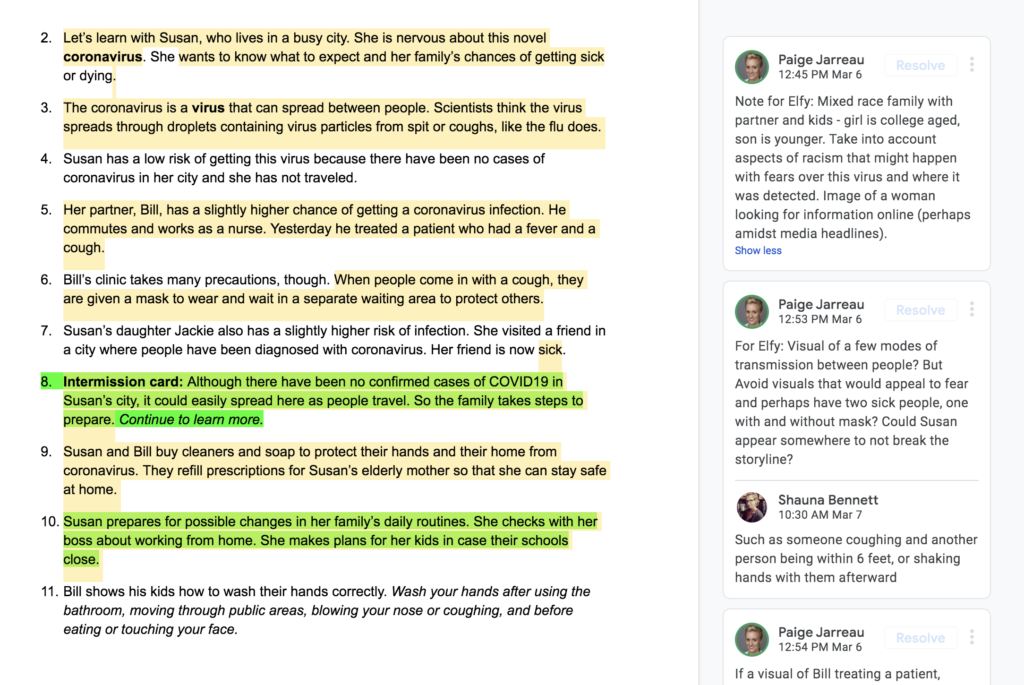
Visual prompts for a Lifeology course
Within about a week of starting to write and fact-check the content for the coronavirus course, Elfy started to storyboard the visuals for the course. From there, Shauna and the Lifeology team (myself and designer Doryan Algarra) provided feedback on the storyboard and final illustration style. (Elfy nailed the illustration style and tone the first time around). Then Elfy completed all of the card illustrations.
Continue reading to learn more about Elfy’s process for this course!
Storyboarding a Coronavirus Course – Elfy’s Process
By Elfy Chiang
There were mainly three things that I took into consideration while creating the illustrations for this course: 1) global audience, 2) a positive attitude, and 2) to be fun but avoid misleading messages.
Global audience
The first thing I had in mind working on this project was to include diverse characters visually. One reason for this is that the outbreak has become a global issue. But I also wanted to communicate the fact that viruses or any other infectious diseases do not discriminate between ethnic groups – anyone can be affected.
This course is relatable to a global audience and having diverse characters can help viewers relate to the content more easily.
The other reason for including diversity in this course is that racism and misconceptions have been emerging due to the COVID-19 outbreak. I wanted to be careful not to portray sick characters as representing a particular ethnic group that might be the target of racism or discrimination.
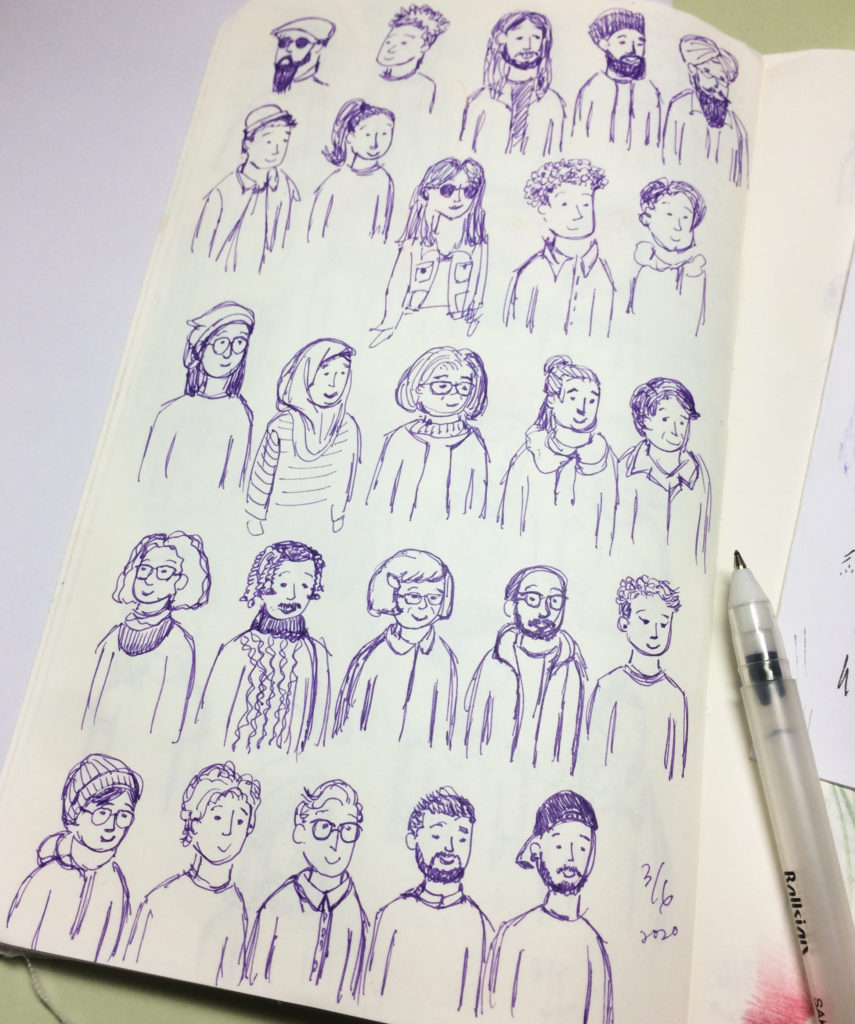
Sketches of diverse characters
Positive vibe
The COVID-19 outbreak (now a pandemic) itself is indeed a terrible event, and we all wish to avoid the illness. But there are things that we can do to protect ourselves, and to do so, we need to believe that we can make a difference. I wanted the characters in this course to be ordinary people that we can all relate to, but also colourful and fun to look at, showing a positive attitude by taking part in being cautious and prepared. I also tried to avoid making drawings of too many sick people, especially elderly sick people. There are senior characters in this course, but they are also positive and caring towards each other.
Fun without misinformation
Creating fun and positive characters is a way to help ease the fear in people due to the COVID-19 pandemic. One part of this course that explains the naming of the virus, where ‘crown’ is mentioned, mentions that coronaviruses are often found in birds and bats. So I had the idea of a king character in connection with the word ‘crown’ and a pet parrot in response to the text. I thought it would be fun to include an unusual character like the king to create a strong impression while the interaction between the king and the pet parrot could stimulate imagination in the viewers. I showed the king washing his hands as a way to emphasize that we are all equal before the virus and that even kings have responsibilities to maintain good personal hygiene.
However, I had to give up on the pet parrot considering that the source of the novel coronavirus is yet unknown and an image of the bird might create misconceptions towards parrots or any kind of birds (or pets), as carriers of this virus, by viewers.
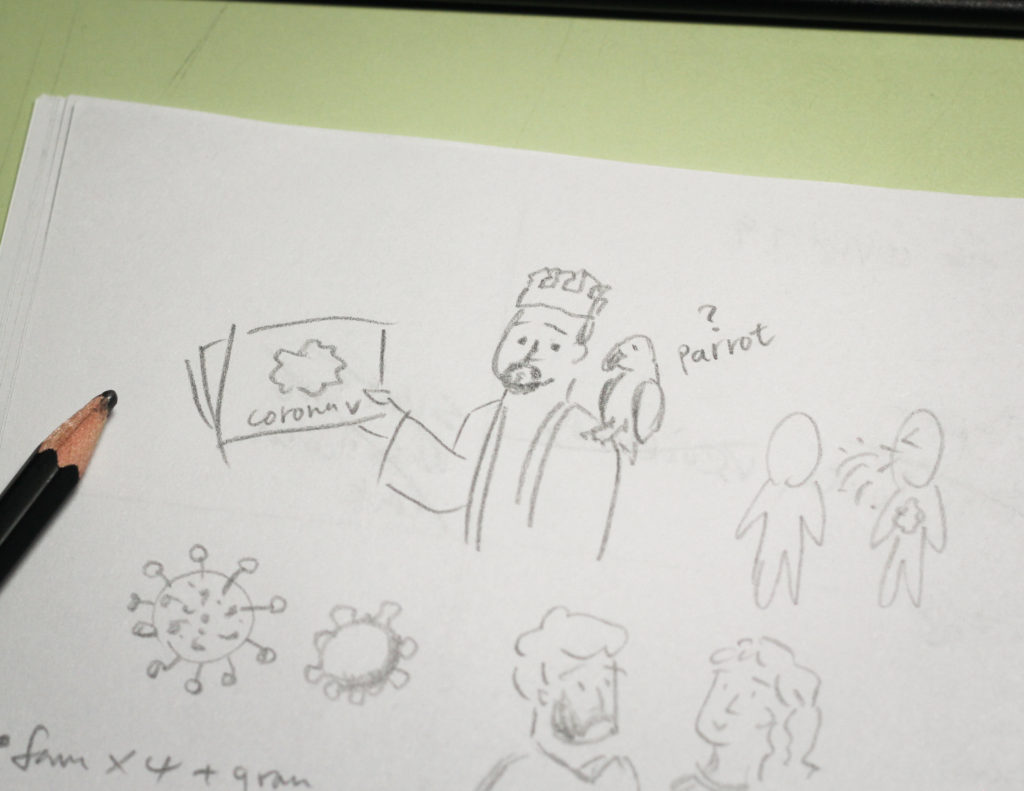
A king with a “corona” crown, by Elfy Chiang.
Wrap-up
Once Elfy had finished all of the card illustrations, and after we and our scientific reviewers had suggested a few accuracy changes (like only putting masks on obviously sick people in the course), it was time to publish the course!
Our Lifeology team engineers are currently in charge of publishing our Lifeology courses. We are still developing a content management system and dashboard for people to build their own courses.
Yesterday, we published the coronavirus course in two languages (Elfy did the Mandarin translation!) with more translations to come. We already have over 2,000 views of the course and dozens of feedback responses, some of which we’ve highlighted below!
This course is published under a CC-BY-SA license, so feel free to use, share and repurpose with attribution to Lifeology, the writer Shauna Bennett and artist Elfy Chiang!
“Thank you for making it easy to understand, I’m sharing it with my children as well. It should be translated to every language and shown on TV.”
“Great overview on the background of coronavirus. I also feel better after going through this course. Fear breeds and learning the facts is very empowering.”
“By far the best resource on bringing awareness about the 2019 Novel Coronavirus. Thank you for all your efforts! Easy to comprehend. Will pass it on to my husband for his work staff.”
“Thank you. This was beyond excellent. Clear, appropriately calming, but direct. Just the right amount of information per slide.”
Want to create your own Lifeology course with us, to build public science and health literacy or combat misinformation? Contact us.
